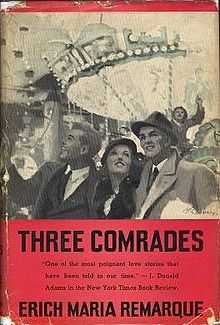Three Comrades (novel)
 First US edition | |
| Author | Erich Maria Remarque |
|---|---|
| Original title | Drei Kameraden |
| Translator | A. W. Wheen |
| Language | German |
| Genre | War novel |
| Publisher |
Little, Brown and Company (US) Hutchinson and Co (UK) |
Publication date |
December 1936 (Dutch transl.) |
Published in English | 1937 |
| ISBN | N/A |
Three Comrades (German: Drei Kameraden) is a novel first published in 1936 by the German author Erich Maria Remarque. It is written in first person by the main character Robert Lohkamp, whose somewhat disillusioned outlook on life is due to his horrifying experiences in the trenches of the First World War's French-German front. He shares these experiences with Otto Köster and Gottfried Lenz, his two comrades with whom he runs an auto-repair shop in late 1920s Berlin (probably). Remarque wrote the novel in exile and it was first published in Dutch translation as Drie kameraden, with English translation following soon in Good Housekeeping from January to March 1937 and in the book form in the same year. First German language edition was published in 1938 by exile publisher Querido in Amsterdam, but the novel was published in Germany only in 1951.
Plot
The city, which is never referred to by name (however, it is likely Berlin), is crowded by a growing number of jobless and marked by increasing violence between left and right. The novel starts out in the seedy milieu of bars where prostitutes mingle with the hopeless flotsam that the war left behind. While Robert and his friends manage to make a living dealing cars and driving an old taxi, economic survival in the city is getting harder by the day. It is in this setting that Robert meets Patrice Hollmann, a mysterious beautiful young woman with an upper-middle-class background. Their love affair intensifies as he introduces her to his life of bars and races and Robert's nihilistic attitude slowly begins to change as he realizes how much he needs Pat.
The story takes an abrupt turn as Pat suffers a near-fatal lung hemorrhage during a summer holiday at the sea. Upon their return, Robert and Pat move in with each other but her days in the city are numbered, as she is scheduled to leave for a Swiss mountain sanatorium come winter. It is this temporal limitation of their happiness which makes their remaining time together so precious.
After Pat has left for Switzerland, the political situation in the city heats up and Lenz, one of the comrades, is killed by a militant, not mentioned in the book by the actual name but supposed to be a Nazi. On top of this, Otto and Robert face bankruptcy and have to sell their workshop. In the midst of this misfortune, a telegram arrives informing them of Pat's worsening state of health. The two remaining comrades don't hesitate and drive the thousand kilometers to the tuberculosis sanatorium in the Alps to see her.
Reunited, Robert and an increasingly moribund Pat celebrate their remaining weeks before her inevitable death amidst the snow-covered summits of Switzerland. It is in the last part of the book that this beautiful love story finds closure and leaves the main character, a nihilist who has found love, forever changed.
Film, TV, and theatrical adaptations
The novel was made into an American film of the same title in 1938 starring Franchot Tone, Robert Taylor, Robert Young and Margaret Sullavan and is also believed to have been the inspiration for director Michael Cimino's 1978 film The Deer Hunter.
Flowers from the Victors (1999), directed by Aleksander Surin, was also based on the novel but set in Russia in the 1990s.
| ||||||